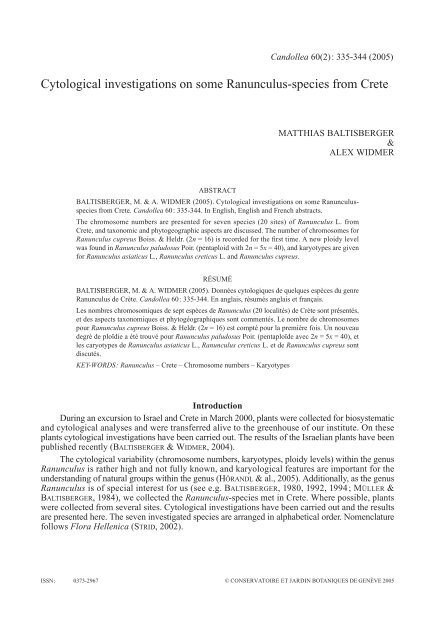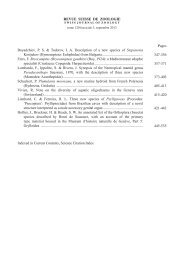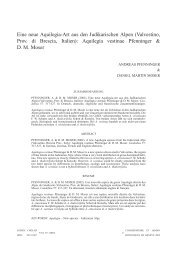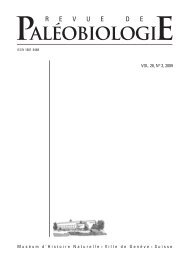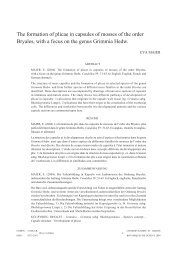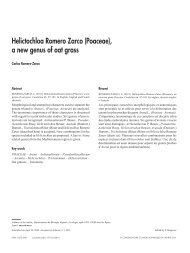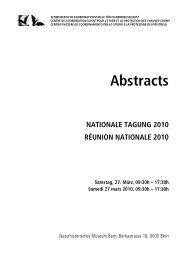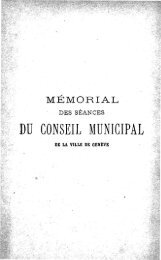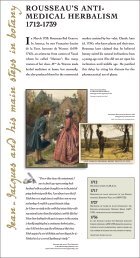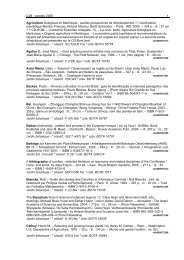Cytological investigations on some Ranunculus ... - Ville de Genève
Cytological investigations on some Ranunculus ... - Ville de Genève
Cytological investigations on some Ranunculus ... - Ville de Genève
You also want an ePaper? Increase the reach of your titles
YUMPU automatically turns print PDFs into web optimized ePapers that Google loves.
Candollea 60(2): 335-344 (2005)<br />
<str<strong>on</strong>g>Cytological</str<strong>on</strong>g> <str<strong>on</strong>g>investigati<strong>on</strong>s</str<strong>on</strong>g> <strong>on</strong> <strong>some</strong> <strong>Ranunculus</strong>-species from Crete<br />
MATTHIAS BALTISBERGER<br />
&<br />
ALEX WIDMER<br />
ABSTRACT<br />
BALTISBERGER, M. & A. WIDMER (2005). <str<strong>on</strong>g>Cytological</str<strong>on</strong>g> <str<strong>on</strong>g>investigati<strong>on</strong>s</str<strong>on</strong>g> <strong>on</strong> <strong>some</strong> <strong>Ranunculus</strong>species<br />
from Crete. Candollea 60: 335-344. In English, English and French abstracts.<br />
The chromo<strong>some</strong> numbers are presented for seven species (20 sites) of <strong>Ranunculus</strong> L. from<br />
Crete, and tax<strong>on</strong>omic and phytogeographic aspects are discussed. The number of chromo<strong>some</strong>s for<br />
<strong>Ranunculus</strong> cupreus Boiss. & Heldr. (2n = 16) is recor<strong>de</strong>d for the first time. A new ploidy level<br />
was found in <strong>Ranunculus</strong> paludosus Poir. (pentaploid with 2n = 5x = 40), and karyotypes are given<br />
for <strong>Ranunculus</strong> asiaticus L., <strong>Ranunculus</strong> creticus L. and <strong>Ranunculus</strong> cupreus.<br />
RÉSUMÉ<br />
BALTISBERGER, M. & A. WIDMER (2005). D<strong>on</strong>nées cytologiques <strong>de</strong> quelques espèces du genre<br />
<strong>Ranunculus</strong> <strong>de</strong> Crète. Candollea 60: 335-344. En anglais, résumés anglais et français.<br />
Les nombres chromosomiques <strong>de</strong> sept espèces <strong>de</strong> <strong>Ranunculus</strong> (20 localités) <strong>de</strong> Crète s<strong>on</strong>t présentés,<br />
et <strong>de</strong>s aspects tax<strong>on</strong>omiques et phytogéographiques s<strong>on</strong>t commentés. Le nombre <strong>de</strong> chromo<strong>some</strong>s<br />
pour <strong>Ranunculus</strong> cupreus Boiss. & Heldr. (2n = 16) est compté pour la première fois. Un nouveau<br />
<strong>de</strong>gré <strong>de</strong> ploïdie a été trouvé pour <strong>Ranunculus</strong> paludosus Poir. (pentaploï<strong>de</strong> avec 2n = 5x = 40), et<br />
les caryotypes <strong>de</strong> <strong>Ranunculus</strong> asiaticus L., <strong>Ranunculus</strong> creticus L. et <strong>de</strong> <strong>Ranunculus</strong> cupreus s<strong>on</strong>t<br />
discutés.<br />
KEY-WORDS: <strong>Ranunculus</strong> – Crete – Chromo<strong>some</strong> numbers – Karyotypes<br />
Introducti<strong>on</strong><br />
During an excursi<strong>on</strong> to Israel and Crete in March 2000, plants were collected for biosystematic<br />
and cytological analyses and were transferred alive to the greenhouse of our institute. On these<br />
plants cytological <str<strong>on</strong>g>investigati<strong>on</strong>s</str<strong>on</strong>g> have been carried out. The results of the Israelian plants have been<br />
published recently (BALTISBERGER & WIDMER, 2004).<br />
The cytological variability (chromo<strong>some</strong> numbers, karyotypes, ploidy levels) within the genus<br />
<strong>Ranunculus</strong> is rather high and not fully known, and karyological features are important for the<br />
un<strong>de</strong>rstanding of natural groups within the genus (HÖRANDL & al., 2005). Additi<strong>on</strong>ally, as the genus<br />
<strong>Ranunculus</strong> is of special interest for us (see e.g. BALTISBERGER, 1980, 1992, 1994; MÜLLER &<br />
BALTISBERGER, 1984), we collected the <strong>Ranunculus</strong>-species met in Crete. Where possible, plants<br />
were collected from several sites. <str<strong>on</strong>g>Cytological</str<strong>on</strong>g> <str<strong>on</strong>g>investigati<strong>on</strong>s</str<strong>on</strong>g> have been carried out and the results<br />
are presented here. The seven investigated species are arranged in alphabetical or<strong>de</strong>r. Nomenclature<br />
follows Flora Hellenica (STRID, 2002).<br />
ISSN: 0373-2967 © CONSERVATOIRE ET JARDIN BOTANIQUES DE GENÈVE 2005
336 CANDOLLEA 60, 2005<br />
The chromo<strong>some</strong> numbers are presented and discussed, including interesting aspects of<br />
systematics and/or geographic distributi<strong>on</strong>. Literature c<strong>on</strong>cerning chromo<strong>some</strong> numbers was checked<br />
using FEDEROV (1974), VAN LOON (1987), as well as the series “In<strong>de</strong>x to plant chromo<strong>some</strong><br />
numbers” (MOORE, 1970, 1971, 1972, 1973, 1974, 1977; GOLDBLATT, 1981, 1984, 1985, 1988;<br />
GOLDBLATT & JOHNSON, 1990, 1991, 1994, 1996, 1998, 2000, 2003). In <strong>Ranunculus</strong> asiaticus L.,<br />
R. creticus L. and R. cupreus Boiss. & Heldr., karyotypes are discussed.<br />
Materials and methods<br />
The cytological <str<strong>on</strong>g>investigati<strong>on</strong>s</str<strong>on</strong>g> were carried out <strong>on</strong> root tips. These were pretreated with<br />
colchicine (0.05%) for 2 hours, then fixed in ethanol/acetic acid (3:1), and stained and squashed<br />
in lacto-propi<strong>on</strong>ic orcein (DYER, 1963). Five to ten metaphases were counted out of each<br />
individual to <strong>de</strong>termine the chromo<strong>some</strong> number, and if possible several individuals were investigated<br />
of each species (or each site, respectively). The numbers of investigated individuals are<br />
indicated in Table 1.<br />
Karyotypes are discussed using the terminology for chromo<strong>some</strong> morphology proposed by<br />
LEVAN & al. (1964). The chromo<strong>some</strong>s are named according to the positi<strong>on</strong> of the centromers,<br />
which is expressed with the arm ratio, “l<strong>on</strong>g arm to short arm”. The following terms are used:<br />
– metacentric arm ratio 1.0-1.7;<br />
– submetacentric arm ratio 1.7-3.0;<br />
– subtelocentric arm ratio 3.0-7.0;<br />
– acrocentric arm ratio more than 7.0;<br />
– telocentric <strong>on</strong>ly <strong>on</strong>e arm.<br />
Plant material<br />
After the indicati<strong>on</strong>s of the site, date of sampling, number of herbarium specimen (in parenthesis<br />
specimen number of cultivated plants) are listed. Specimens are <strong>de</strong>posited in Z + ZT.<br />
1. <strong>Ranunculus</strong> asiaticus L.<br />
GREECE. Crete: Meadow, M<strong>on</strong>i Kardiotissis, near Krasi<strong>on</strong>, N. Irakli<strong>on</strong>, 18.IV.1996, leg. F.<br />
Klötzli (M. Baltisberger 13230); Open slope, W of Mires, N. Irakli<strong>on</strong>, 18.III.2000, M. Baltisberger<br />
& A. Widmer 13545 (M. Baltisberger 13731); Rocky slope, NNW of Ag. Galini, <strong>on</strong> the road from<br />
Ag. Galini to Spili, N. Rethimno, 19.III.2000, (M. Baltisberger 13740); Bushland near Lampini,<br />
WNW of Spili, N. Rethimno, 20.III.2000, (M. Baltisberger 13744); Rocky slope between Selia<br />
and Rodakino, W of Spili, N. Rethimno, 20.III.2000, (M. Baltisberger 13741).<br />
2. <strong>Ranunculus</strong> creticus L.<br />
GREECE. Crete: Rocks in the gorge of Therisso, near Omalos, SSW of Chania, N. Chania,<br />
18.IV.1991, M. Eggenberger & B. Merz (M. Baltisberger 12793); N exposed, rocky slope, NNW<br />
of Ag. Galini, <strong>on</strong> the road from Ag. Galini to Spili, N. Rethimno, 19.III.2000, M. Baltisberger &<br />
A. Widmer 13555 (M. Baltisberger 13716); Gorge S of Ag. Ioanis, <strong>on</strong> the road from Rethimno to<br />
Selia, SSW of Rethimno, N. Rethimno, 20.III.2000, M. Baltisberger & A. Widmer 13559 (M. Baltisberger<br />
13722); N exposed rocks near the branches to Roustika off the road from Atsipopoulo to<br />
Episkopi, WSW of Rethimno, N. Rethimno, 21.III.2000, M. Baltisberger & A. Widmer 13561 (M.<br />
Baltisberger 13726).
CYTOLOGICAL INVESTIGATIONS ON SOME RANUNCULUS-SPECIES FROM CRETE 337<br />
3. <strong>Ranunculus</strong> cupreus Boiss. & Heldr.<br />
GREECE. Crete: Rocky slope between Selia and Rodakino, W of Spili, N. Rethimno,<br />
20.III.2000, M. Baltisberger & A. Widmer 13558 (M. Baltisberger 13721, M. Baltisberger 13811,<br />
M. Baltisberger 13892; duplicates in herb. Kit Tan, Copenhagen).<br />
4. <strong>Ranunculus</strong> ficaria L.<br />
GREECE. Crete: Wet place in culture of Olea europaea L., near Lampini, WNW of Spili,<br />
N. Rethimno, 20.III.2000, M. Baltisberger & A. Widmer 13557 (M. Baltisberger 13719); Wet place<br />
in culture of Olea europaea L., between Episkopi and Kournas, WSW of Rethimno, N. Chania,<br />
21.III.2000, M. Baltisberger & A. Widmer 13560 (M. Baltisberger 13724).<br />
5. <strong>Ranunculus</strong> marginatus d’Urv.<br />
GREECE. Crete: Wet ru<strong>de</strong>ral place, NW of Ag. Galini, <strong>on</strong> the road from Ag. Galini to Spili,<br />
N. Rethimno, 19.III.2000, (M. Baltisberger 13717).<br />
6. <strong>Ranunculus</strong> muricatus L.<br />
GREECE. Crete: Wet ru<strong>de</strong>ral place, NW of Ag. Galini, <strong>on</strong> the road from Ag. Galini to Spili,<br />
N. Rethimno, 19.III.2000, (M. Baltisberger 13718); Open wet place in culture of Olea europaea<br />
L., near Lampini, WNW of Spili, N. Rethimno, 20.III.2000, (M. Baltisberger 13720); Wet ru<strong>de</strong>ral<br />
place in the gorge S of Ag. Ioanis, <strong>on</strong> the road from Rethimno to Selia, SSW of Rethimno,<br />
N. Rethimno, 20.III.2000, (M. Baltisberger 13723); Open wet place in culture of Olea europaea<br />
L., between Episkopi and Kournas, WSW of Rethimno, N. Chania, 21.III.2000, (M. Baltisberger<br />
13725).<br />
7. <strong>Ranunculus</strong> paludosus Poir.<br />
GREECE. Crete: Slope near Krasi<strong>on</strong>, N. Irakli<strong>on</strong>, 17.IV.1996, leg. F. Klötzli (M. Baltisberger<br />
13231); Culture of Olea europaea L., NW of Ag. Galini, <strong>on</strong> the road from Ag. Galini<br />
to Spili, N. Rethimno, 19.III.2000, (M. Baltisberger 13814); Bushland near Lampini, WNW of<br />
Spili, N. Rethimno, 20.III.2000, (M. Baltisberger 13815).<br />
Results and discussi<strong>on</strong><br />
1. <strong>Ranunculus</strong> asiaticus (2n = 16; Fig. 1A)<br />
<strong>Ranunculus</strong> asiaticus is a rather variable species growing in open and waste places and shrubby<br />
vegetati<strong>on</strong>s in the Mediterranean and W Irano-Turanian area. It varies in the shape of the leaves<br />
and the colour of the flowers (red, white, and yellow), and several variants have been named. All<br />
plants from all five sites have undivi<strong>de</strong>d or 3-fid lower leaves with broad lobes as well as white<br />
flowers, <strong>on</strong>ly few plants from Lampini (M. Baltisberger 13744) showed flowers tinged pale<br />
rose-pink. As different morphological characters may occur in the same populati<strong>on</strong>, all varieties<br />
seem to fall within <strong>on</strong>e range of variati<strong>on</strong> of R. asiaticus and have therefore no systematic value<br />
(STRID, 2002). But there seems to be a ten<strong>de</strong>ncy for the geographical distributi<strong>on</strong> of the flower<br />
colours, plants from Greece showing mostly white flowers and plants from more eastern parts as<br />
Turkey (DAVIS, 1965) or Israel (BALTISBERGER & WIDMER, 2004) are red flowered.<br />
All plants investigated from all five sites were diploid with 2n = 16 chromo<strong>some</strong>s. The<br />
chromo<strong>some</strong> number corresp<strong>on</strong>ds with the indicati<strong>on</strong>s in literature. The karyotype c<strong>on</strong>sists of<br />
6 metacentric, 8 submeta- to subtelocentric and 2 acrocentric chromo<strong>some</strong>s (6m 8sm/st 2a),
338 CANDOLLEA 60, 2005<br />
similar karyotypes are given by GOEPFERT (1974), TZANOUDAKIS (1986), TAK & WAFAI (1996),<br />
and BALTISBERGER & WIDMER (2004). As similar karyotypes have been found in plants from<br />
both colour types no cytological difference seems to exist between white or red coloured plants<br />
from the respective areas.<br />
2. <strong>Ranunculus</strong> creticus (2n = 16; Fig. 1B)<br />
<strong>Ranunculus</strong> creticus occurs in the S Aegean area and grows in shaddy places <strong>on</strong> rocky ledges<br />
and in gorges. It is a distinct, beautiful and often rather tall species. As it grows in similar habitats<br />
and looks like the even larger R. cortusifolius Willd. from the Macar<strong>on</strong>esian islands it was<br />
suggested that these two species are closely related (GOEPFERT, 1976). But molecular data suggest<br />
(PAUN & al., 2005) that the two species are not as closely related. They join the same cla<strong>de</strong> but they<br />
are each nested within a group of more or less the same phytogeographical regi<strong>on</strong> (W- respectively<br />
E-Mediterranean). The similar habit is probably an in<strong>de</strong>pen<strong>de</strong>nt adaptati<strong>on</strong> to the sha<strong>de</strong>d habitat.<br />
Nevertheless, based <strong>on</strong> data of chloroplast DNA, JOHANNSON (1998) found a str<strong>on</strong>gly supported<br />
m<strong>on</strong>ophyletic group with both R. cortusifolius and R. creticus as well as <strong>some</strong> other species (e.g.<br />
R. asiaticus).<br />
All plants investigated from all four sites had 16 chromo<strong>some</strong>s and were thus diploid. This<br />
corresp<strong>on</strong>ds with GOEPFERT (1974), MONTMOLLIN (1986), and TZANOUDAKIS (1986). The karyotype<br />
c<strong>on</strong>sists of 6 metacentric, 8 submeta- to subtelocentric and 2 acrocentric chromo<strong>some</strong>s, the latter<br />
with satellites (6m 8sm/st 2aSAT). Similar karyotypes are given by GOEPFERT (1974) and<br />
TZANOUDAKIS (1986). These findings for R. creticus corresp<strong>on</strong>d with the karyotype data for other<br />
<strong>Ranunculus</strong>-species, e.g. R. asiaticus (see above) and R. cortusifolius (GOEPFERT, 1974; DALGAARD,<br />
1985; BALTISBERGER & al., 1990). These three species are not closely related (PAUN & al., 2005)<br />
but bel<strong>on</strong>g to a m<strong>on</strong>ophyletic group (JOHANNSON, 1998).<br />
3. <strong>Ranunculus</strong> cupreus (2n = 16; Fig. 1C)<br />
<strong>Ranunculus</strong> cupreus is an en<strong>de</strong>mic species of Crete growing in crevices and ledges <strong>on</strong><br />
limest<strong>on</strong>e, often with phrygana. It is a small species (up to 15 cm) characterized by its sparsely<br />
pubescent leaves 3-partite to base with rather <strong>de</strong>eply 3-partite lobes and the h<strong>on</strong>ey-leaves yellow<br />
above but copper-coloured beneath. However, the plants <strong>on</strong> which the cytological <str<strong>on</strong>g>investigati<strong>on</strong>s</str<strong>on</strong>g><br />
were based have basal leaves which are completely glabrous and more than normally lobed<br />
(see Fig. 2), and they lack the reddish tinge of the outsi<strong>de</strong> of the h<strong>on</strong>ey-leaves (fi<strong>de</strong> Kit Tan). <strong>Ranunculus</strong><br />
cupreus looks rather similar to R. millefoliatus Vahl differing in size, less divi<strong>de</strong>d leaves,<br />
and the copper-coloured h<strong>on</strong>ey-leaves. The close relati<strong>on</strong>ship of these two species is supported by<br />
molecular data (PAUN & al., 2005).<br />
The chromo<strong>some</strong> number of R. cupreus was not known up to now. With 16 chromo<strong>some</strong>s the<br />
plants proved to be diploid. The same number is given for the related R. millefoliatus (GARBARI &<br />
al., 1973; POPOVA, 1973; GOEPFERT, 1974; MARCHI & VISONA, 1982; SHOPOVA & SEKOVSKI, 1982).<br />
The karyotype of R. cupreus c<strong>on</strong>sists of 3 pairs of metacentric, 3 pairs of meta- to submetacentric,<br />
1 pair of subtelocentric and 1 pair of acrocentric chromo<strong>some</strong>s, the subtelo- and acrocentric<br />
chromo<strong>some</strong>s bearing satellites (6m 6m/sm 2stSAT 2aSAT). Similar karyotypes are given for R. millefoliatus<br />
by GOEPFERT (1974), MARCHI & VISONA (1982) and SHOPOVA & SEKOVSKI (1982).<br />
4. <strong>Ranunculus</strong> ficaria (2n = 32)<br />
<strong>Ranunculus</strong> ficaria is wi<strong>de</strong>spread <strong>on</strong> wet and shady places in Europe, Asia, and N Africa and<br />
introduced in northern America. It is very variable and tax<strong>on</strong>omically difficult, and several ploidy<br />
levels (viz. 2x, 3x, 4x) as well as aneuploid individuals (HESS & al., 1977) are known. Based <strong>on</strong><br />
morphological characters <strong>some</strong> previous authors (e.g. JANCHEN, 1949) suggested to treat R. ficaria
CYTOLOGICAL INVESTIGATIONS ON SOME RANUNCULUS-SPECIES FROM CRETE 339<br />
and its allied species as a seperate genus Ficaria Schaeff. but in most floras it remained within<br />
<strong>Ranunculus</strong>. Nevertheless molecular data support the separati<strong>on</strong> of Ficaria as a distinct genus<br />
(HÖRANDL & al., 2005; PAUN & al., 2005).<br />
Plants from the Mediterranean regi<strong>on</strong> have been referred to <strong>Ranunculus</strong> ficaria subsp. ficariiformis<br />
(F. W. Schultz) Rouy & Foucaud. Greek plants normally lack bulbils in the leaf axils which<br />
is typical for this subspecies; they therefore have been recently <strong>de</strong>scribed as a distinct tetraploid<br />
subspecies, R. ficaria subsp. chrysocephalus P. D. Sell (SELL, 1991), and this seems to be the <strong>on</strong>ly<br />
tax<strong>on</strong> of the group occuring in S Greece and the Aegean regi<strong>on</strong> (STRID, 2002). Plants of both sites<br />
from Crete proved to be tetraploid with 2n = 4x = 32 chromo<strong>some</strong>s c<strong>on</strong>firming the indicati<strong>on</strong> by<br />
SELL (1991).<br />
5. <strong>Ranunculus</strong> marginatus (2n = 16)<br />
<strong>Ranunculus</strong> marginatus grows in open vegetati<strong>on</strong>s <strong>on</strong> wet places, in aband<strong>on</strong>ed fields and <strong>on</strong><br />
roadsi<strong>de</strong>s. Its distributi<strong>on</strong> is said to cover SE Europe. Two varieties are distinguished (TUTIN &<br />
AKEROYD, 1993). Typical R. marginatus with smooth achenes is diploid with 2n = 2x = 16 chromo<strong>some</strong>s<br />
(STRID & FRANZEN, 1981; LENTINI & al., 1988; BALTISBERGER & al., 1993) whereas<br />
R. marginatus var. trachycarpus (Fisch. & C. A. Mey.) Azn. with tuberculate achenes is tetraploid<br />
(LANGLET, 1927; GREGSON, 1965; GOEPFERT, 1974; SLAVIK & al., 1993; BALTISBERGER &<br />
BALTISBERGER, 1995). As many annuals, R. marginatus varies greatly in size, branching mo<strong>de</strong>, and<br />
number of flowers. But it also varies in tax<strong>on</strong>omically relevant morphological characters of the<br />
achenes such as size, broadness of the margin, length of the beak, and surface (smooth, variously<br />
tuberculate till even muricate). This is also the case with the plants from Crete showing achenes<br />
with the surface from completely smooth to <strong>de</strong>nsely tuberculate (Fig. 3). All plants investigated<br />
were diploid with 2n = 2x = 16, even these plants with tuberculate achenes. So the correlati<strong>on</strong><br />
between ploidy level and variety seems to be unexistent (at least for the material from Crete).<br />
<strong>Ranunculus</strong> marginatus often looks similar to the annual, wi<strong>de</strong>spread and also very variable<br />
R. sardous Crantz, and the two taxa are therefore often difficult to distinguish. R. sardous is diploid<br />
or tetraploid, and the surface of the achenes is also variable as in R. marginatus. At least at present<br />
no geographical pattern based <strong>on</strong> morphology and/or cytology can be <strong>de</strong>tected within this<br />
complex, and it therefore was proposed to treat the respective taxa as a variable complex un<strong>de</strong>r the<br />
name of R. sardous (STRID, 2002). But molecular data indicate that the two species are not (HÖRANDL<br />
& al., 2005) or at least not closely related (PAUN & al., 2005).<br />
6. <strong>Ranunculus</strong> muricatus (2n = 48)<br />
<strong>Ranunculus</strong> muricatus is a wi<strong>de</strong>spread annual in the Mediterranean area and introduced in<br />
other regi<strong>on</strong>s with similar climate. It grows in open vegetati<strong>on</strong> <strong>on</strong> wet places, in aband<strong>on</strong>ed fields<br />
and disturbed grounds. The species is polyploid, and three levels are known viz. tetraploid with 32<br />
(VAN LOON & DE JONG, 1978), hexaploid with 48 (e.g. DIOSDADO & PASTOR, 1996), and octoploid<br />
with 64 chromo<strong>some</strong>s (FUJISHIMA, 1986). Based <strong>on</strong> ploidy levels no geographical pattern seems to<br />
exist. All investigated plants from all four sites from Crete proved to be hexaploid with 2n = 6x =<br />
48 chromo<strong>some</strong>s which is the most comm<strong>on</strong> ploidy level within R. muricatus.<br />
7. <strong>Ranunculus</strong> paludosus (2n = 32, 40; Fig. 1D)<br />
<strong>Ranunculus</strong> paludosus grows in dry or seas<strong>on</strong>ally wet meadows, in aband<strong>on</strong>ed fields and open<br />
places in bushland. It is a variable and wi<strong>de</strong>spread species in the Mediterranean area. Two ploidy<br />
levels are known viz. diploid with 2n = 2x = 16 and tetraploid with 2n = 4x = 32. The investigated<br />
plants from Krasi<strong>on</strong> proved to be tetraploid, c<strong>on</strong>firming the ploidy level more frequently indicated<br />
in literature. But all plants from the other two sites were pentaploid with 2n = 5x = 40 which was<br />
unknown within this species up to now (Fig. 1D).
340 CANDOLLEA 60, 2005<br />
The pentaploid plants could originate by combining a reduced gamete of a diploid with a unreduced<br />
gamete of a tetraploid plant. But as diploid R. paludosus is not known from Crete the origin<br />
of the pentaploid plants remains unclear. Pentaploid plants show an uneven ploidy level. Complete<br />
pairing of chromo<strong>some</strong>s in meiosis is therefore not possible. The result is an unregular meiosis,<br />
and those plants are probably not fertile. But as all plants produce subterranean stol<strong>on</strong>s (up to ten<br />
stol<strong>on</strong>s per plant!) which grow very fast and build remarcable rosettes of leaves within <strong>some</strong> weeks<br />
(at least in the greenhouse) the propagati<strong>on</strong> of these pentaploid plants seems to be no problem.<br />
This was probably also the case in nature because both sites were rather <strong>de</strong>nsely covered with<br />
numerous rosettes of this species. A similar strategy was <strong>de</strong>scribed for plants of R. dissectus subsp.<br />
sibthorpii Davis with an uneven ploidy level (here triploid) from Ulu Dag in Turkey (BALTISBERGER<br />
& TAN, 1991). This tax<strong>on</strong> usually is diploid and without stol<strong>on</strong>s but a populati<strong>on</strong> of triploid plants<br />
was found producing subterranean stol<strong>on</strong>s.<br />
ACKNOWLEDGEMENTS<br />
We thank Prof. Dr. F. Klötzli (Zürich) and Dr. B. Merz (Geneva) for the Ranunculi sampled in Crete, and<br />
Dr. K. Tan (Copenhagen) for the support with <strong>Ranunculus</strong> cupreus. We are very grateful to A. Skoumalova (Prague)<br />
for a draft sketch of Fig. 2. We also thank an an<strong>on</strong>ymous reviewer for critical comments <strong>on</strong> the manuscript.<br />
REFERENCES<br />
BALTISBERGER, M. (1980). Die Artengruppe <strong>de</strong>s <strong>Ranunculus</strong> polyanthemos L. in Europa. Ber. Schweiz. Bot. Ges. 90: 143-188.<br />
BALTISBERGER, M. (1992). Botanische Notizen und zytologische Untersuchungen an einigen Pflanzen (insbes<strong>on</strong><strong>de</strong>re aus <strong>de</strong>n<br />
Gattungen <strong>Ranunculus</strong> und Achillea) aus <strong>de</strong>m albanisch-jugoslawischen Grenzgebiet (Korab, Sar Planina). Ber. Geobot.<br />
Inst. E. T. H. Stiftung Rübel 58: 192-211.<br />
BALTISBERGER, M. (1994). <strong>Ranunculus</strong> cacuminis and R. crenatus, representatives of the R. alpestris-group (Ranunculaceae)<br />
<strong>on</strong> the Balkan Peninsula. Pl. Syst. Evol. 190: 231-244.<br />
BALTISBERGER, M. & E. BALTISBERGER (1995). <str<strong>on</strong>g>Cytological</str<strong>on</strong>g> data of Albanian plants. Candollea 50: 457-493.<br />
BALTISBERGER, M., W. HUBER & B. MERZ (1990). Zytologische Untersuchungen an einigen Pflanzen v<strong>on</strong> <strong>de</strong>n Kanarischen<br />
Inseln. Ber. Geobot. Inst. E. T. H. Stiftung Rübel 56: 142-149.<br />
BALTISBERGER, M., A. MULLAJ & V. TARTARI (1993). Mediterranean chromo<strong>some</strong> number reports 3 (185-203). Fl. Medit.<br />
3: 348-353.<br />
BALTISBERGER, M. & K. TAN (1991). Investigati<strong>on</strong>s in <strong>Ranunculus</strong> dissectus subsp. sibthorpii (Ranunculaceae). Will<strong>de</strong>nowia<br />
20: 67-72.<br />
BALTISBERGER, M. & A. WIDMER (2004). <str<strong>on</strong>g>Cytological</str<strong>on</strong>g> data of <strong>some</strong> plants species from Israel. Israel J. Plant Sci. 52: 171-176.<br />
DALGAARD, V. (1985). Chromo<strong>some</strong> studies in flowering plants from Ma<strong>de</strong>ira. Will<strong>de</strong>nowia 15: 137-156.<br />
DAVIS, P. H. (1965). <strong>Ranunculus</strong> L. In: DAVIS, P. H. (ed.), Fl. Turkey 1: 146-197.<br />
DIOSDADO, J. C. & J. E. PASTOR (1996). C<strong>on</strong>si<strong>de</strong>raci<strong>on</strong>es citotax<strong>on</strong>omicas <strong>de</strong>l genero <strong>Ranunculus</strong> L. (Ranunculaceae) en la<br />
Peninsula Iberica. Anales Jard. Bot. Madrid 54: 166-178.<br />
DYER, A. F. (1963). The use of lacto-propi<strong>on</strong>ic orcein in rapid squash methods for chromo<strong>some</strong> preparati<strong>on</strong>s. Stain Technol.<br />
38: 85-90.<br />
FEDEROV, A. (1974). Chromo<strong>some</strong> numbers of flowering plants. Koeltz.<br />
FUJISHIMA, H. (1986). A new chromo<strong>some</strong> number of <strong>Ranunculus</strong> muricatus L. Kromosomo II 43-44: 1367-1371.<br />
GARBARI, F., N. TORNADORE & E. PECORI (1973). Numeri cromosomici per la Flora Italiana: 151-161. Inform. Bot. Ital. 5:<br />
161-169.<br />
GOEPFERT, D. (1974). Karyotypes and DNA c<strong>on</strong>tent in species of <strong>Ranunculus</strong> L. and related genera. Bot. Not. 127: 464-489.<br />
GOEPFERT, D. (1976). Phylogenetic studies <strong>on</strong> <strong>Ranunculus</strong> cortusifolius Willd. (Ranunculaceae), a Macar<strong>on</strong>esian en<strong>de</strong>mic<br />
species. Bot. J. Linn. Soc. 72: 161-170.<br />
GOLDBLATT, P. (1981). In<strong>de</strong>x to plant chromo<strong>some</strong> numbers 1975-1978. M<strong>on</strong>ogr. Syst. Bot. Missouri Bot. Gard. 5: 1-533.
CYTOLOGICAL INVESTIGATIONS ON SOME RANUNCULUS-SPECIES FROM CRETE 341<br />
GOLDBLATT, P. (1984). In<strong>de</strong>x to plant chromo<strong>some</strong> numbers 1979-1981. M<strong>on</strong>ogr. Syst. Bot. Missouri Bot. Gard. 8: 1-427.<br />
GOLDBLATT, P. (1985). In<strong>de</strong>x to plant chromo<strong>some</strong> numbers 1982-1983. M<strong>on</strong>ogr. Syst. Bot. Missouri Bot. Gard. 13: 1-224.<br />
GOLDBLATT, P. (1988). In<strong>de</strong>x to plant chromo<strong>some</strong> numbers 1984-1985. M<strong>on</strong>ogr. Syst. Bot. Missouri Bot. Gard. 23: 1-264.<br />
GOLDBLATT, P. & D. E. JOHNSON (1990). In<strong>de</strong>x to plant chromo<strong>some</strong> numbers 1986-1987. M<strong>on</strong>ogr. Syst. Bot. Missouri Bot.<br />
Gard. 30: 1-243.<br />
GOLDBLATT, P. & D. E. JOHNSON (1991). In<strong>de</strong>x to plant chromo<strong>some</strong> numbers 1988-1989. M<strong>on</strong>ogr. Syst. Bot. Missouri Bot.<br />
Gard. 40: 1-238.<br />
GOLDBLATT, P. & D. E. JOHNSON (1994). In<strong>de</strong>x to plant chromo<strong>some</strong> numbers 1990-1991. M<strong>on</strong>ogr. Syst. Bot. Missouri Bot.<br />
Gard. 51: 1-267.<br />
GOLDBLATT, P. & D. E. JOHNSON (1996). In<strong>de</strong>x to plant chromo<strong>some</strong> numbers 1992-1993. M<strong>on</strong>ogr. Syst. Bot. Missouri Bot.<br />
Gard. 58: 1-276.<br />
GOLDBLATT, P. & D. E. JOHNSON (1998). In<strong>de</strong>x to plant chromo<strong>some</strong> numbers 1994-1995. M<strong>on</strong>ogr. Syst. Bot. Missouri Bot.<br />
Gard. 69: 1-208.<br />
GOLDBLATT, P. & D. E. JOHNSON (2000). In<strong>de</strong>x to plant chromo<strong>some</strong> numbers 1996-1997. M<strong>on</strong>ogr. Syst. Bot. Missouri Bot.<br />
Gard. 81: 1-188.<br />
GOLDBLATT, P. & D. E. JOHNSON (2003). In<strong>de</strong>x to plant chromo<strong>some</strong> numbers 1998-2000. M<strong>on</strong>ogr. Syst. Bot. Missouri Bot.<br />
Gard. 94: 1-297.<br />
GREGSON, N. M. (1965). Chromo<strong>some</strong> morphology and cytogenetics in the genus <strong>Ranunculus</strong> L. PhD thesis. University<br />
of Liverpool.<br />
HESS, H. E., E. LANDOLT & R. HIRZEL (1977). Fl. Schweiz ed. 2, 2. Birkhäuser Verlag.<br />
HÖRANDL, E., O. PAUN, J. T. JOHANSSON, C. LEHNEBACH, T. ARMSTRONG, L. CHEN & P. LOCKHART (2005). Phylogenetic<br />
relati<strong>on</strong>ships and evoluti<strong>on</strong>ary traits in <strong>Ranunculus</strong> s.l. (Ranunculaceae) inferred from ITS sequence analysis. Molec.<br />
Phylogen. Evol. 36: 305-327.<br />
JANCHEN, E. (1949). Die systematische Glie<strong>de</strong>rung <strong>de</strong>r Ranunculaceen und Berberidaceen. Denkschr. Österr. Akad. Wiss.,<br />
Math.-Naturwiss. Kl. 108: 1-82.<br />
JOHANSSON, J. T. (1998). Chloroplast DNA restricti<strong>on</strong> site mapping and the phylogeny of <strong>Ranunculus</strong> (Ranunculaceae).<br />
Pl. Syst. Evol. 213: 1-19.<br />
LANGLET, O. F. I. (1927). Beiträge zur Zytologie <strong>de</strong>r Ranunculazeen. Svensk Bot. Tidskr. 21: 1-17.<br />
LENTINI, F., S. ROMANO & F. M. RAIMONDO (1988). Numeri cromosomici per la Flora Italiana: 1185-1196. Inform. Bot. Ital.<br />
20: 637-646.<br />
LEVAN, A., K. FREDGA & A. A. SANDBERG (1964). Nomenclature for centromeric positi<strong>on</strong> <strong>on</strong> chromo<strong>some</strong>s. Hereditas 52:<br />
201-220.<br />
MARCHI, P. & L. VISONA (1982). Numeri cromosomici per la Flora Italiana: 889-905. Inform. Bot. Ital. 14: 248-258.<br />
MONTMOLLIN, B. DE (1986). Etu<strong>de</strong> cytotax<strong>on</strong>omique <strong>de</strong> la flore <strong>de</strong> la Crète. III. Nombres chromosomiques. Candollea 41: 431-439.<br />
MOORE, R. J. (1970). In<strong>de</strong>x to plant chromo<strong>some</strong> numbers 1968. Regnum Veg. 68: 1-115.<br />
MOORE, R. J. (1971). In<strong>de</strong>x to plant chromo<strong>some</strong> numbers 1969. Regnum Veg. 77: 1-112.<br />
MOORE, R. J. (1972). In<strong>de</strong>x to plant chromo<strong>some</strong> numbers 1970. Regnum Veg. 90: 1-134.<br />
MOORE, R. J. (1973). In<strong>de</strong>x to plant chromo<strong>some</strong> numbers 1967-1971. Regnum Veg. 90: 1-539.<br />
MOORE, R. J. (1974). In<strong>de</strong>x to plant chromo<strong>some</strong> numbers 1972. Regnum Veg. 91: 1-108.<br />
MOORE, R. J. (1977). In<strong>de</strong>x to plant chromo<strong>some</strong> numbers 1973/74. Regnum Veg. 96: 1-257.<br />
MÜLLER, M. & M. BALTISBERGER (1984). Cytotax<strong>on</strong>omische Untersuchungen in <strong>de</strong>r Artengruppe <strong>de</strong>s <strong>Ranunculus</strong> alpestris<br />
(Ranunculaceae). Pl. Syst. Evol. 145: 269-289.<br />
PAUN, O., C. LEHNEBACH, J. T. JOHANSSON, P. LOCKHART & E. HÖRANDL (2005). Phylogenetic relati<strong>on</strong>ships and biogeography<br />
of <strong>Ranunculus</strong> and allied genera (Ranunculaceae) in the Mediterranean regi<strong>on</strong> and in the European Alpine<br />
System. Tax<strong>on</strong> 54, in press.<br />
POPOVA, M. (1973). Cytotax<strong>on</strong>omic investigati<strong>on</strong> in genus <strong>Ranunculus</strong> L. Izv. Bot. Inst. (Sofia) 24: 233-239.<br />
SELL, P. D. (1991). A new subspecies of <strong>Ranunculus</strong> ficaria L. Bot. J. Linn. Soc. 106: 117-118.<br />
SHOPOVA, M. & Z. SEKOVSKI (1982). Chromo<strong>some</strong> atlas of <strong>some</strong> Maced<strong>on</strong>ian angiosperms. Maced<strong>on</strong>ian Aca<strong>de</strong>my<br />
of Sciences and Arts.
342 CANDOLLEA 60, 2005<br />
SLAVIK, B., V. JAROLIMOVA & J. CHRTEK (1993). Chromo<strong>some</strong> counts of <strong>some</strong> plants from Cyprus. Candollea 48: 221-230.<br />
STRID, A. (2002). <strong>Ranunculus</strong> L. In: STRID, A. & K. TAN (ed.), Fl. Hellen. 2: 38-69.<br />
STRID, A. & R. FRANZEN (1981). Chromo<strong>some</strong> numbers. In: LÖVE, A. (ed.), Chromo<strong>some</strong> number reports LXXIII. Tax<strong>on</strong> 30:<br />
829-842.<br />
TAK, M. A. & B. A. WAFAI (1996). Somatic chromo<strong>some</strong> structure and nucleolar organizati<strong>on</strong> in Anem<strong>on</strong>e cor<strong>on</strong>aria<br />
L., <strong>Ranunculus</strong> asiaticus L. and Eranthis hyemalis Salisb. (Ranunculaceae). Phytomorphology 46: 377-385.<br />
TUTIN, T. G. & J. R. AKEROYD (1993). <strong>Ranunculus</strong> L. In: TUTIN, T. G. & al. (ed.), Fl. Eur. 1, ed. 2: 269-286.<br />
TZANOUDAKIS, D. (1986). Chromo<strong>some</strong> studies in the Greek flora. I. Karyotypes of <strong>some</strong> Aegean Angiosperms. Bot. Helv.<br />
96: 27-36.<br />
VAN LOON, J. C. (1987). A cytotax<strong>on</strong>omical atlas of the Balkan flora. J. Cramer.<br />
VAN LOON, J. C. & H. DE JONG (1978). Chromo<strong>some</strong> numbers. In: LÖVE, A. (ed.), Chromo<strong>some</strong> number reports LIX. Tax<strong>on</strong><br />
27: 56-60.<br />
Submitted <strong>on</strong> March 8, 2005<br />
Accepted <strong>on</strong> October 31, 2005<br />
Address of the authors: Geobotanisches Institut, CHN, ETH-Zentrum, CH-8092 Zürich, Switzerland. Email (MB):<br />
balti@ethz.ch
CYTOLOGICAL INVESTIGATIONS ON SOME RANUNCULUS-SPECIES FROM CRETE 343<br />
Table 1. – Alphabetical list of investigated species (* first record, + new ploidy level).<br />
Species Voucher Number of individuals 2n<br />
number investigated<br />
<strong>Ranunculus</strong> asiaticus 13230 1 16<br />
R. asiaticus 13545 9 16<br />
R asiaticus 13740 5 16<br />
R. asiaticus 13744 9 16<br />
R. asiaticus 13741 9 16<br />
R. creticus 12793 9 16<br />
R. creticus 13555 12 16<br />
R. creticus 13559 8 16<br />
R. creticus 13561 10 16<br />
R. cupreus 13558 10 16*<br />
R. ficaria 13557 13 32<br />
R. ficaria 13560 6 32<br />
R. marginatus 13717 6 16<br />
R. muricatus 13718 7 48<br />
R. muricatus 13720 15 48<br />
R. muricatus 13723 4 48<br />
R. muricatus 13725 9 48<br />
R. paludosus 13231 3 32<br />
R. paludosus 13814 14 40+<br />
R. paludosus 13815 13 40<br />
A<br />
C<br />
B<br />
10 µm<br />
Fig. 1. – Somatic metaphases. A. <strong>Ranunculus</strong> asiaticus L. (M. Baltisberger & A. Widmer 13545; 2n = 2x = 16); B. <strong>Ranunculus</strong><br />
creticus L. (M. Baltisberger & A. Widmer 13561; 2n = 2x = 16); C. <strong>Ranunculus</strong> cupreus Boiss. & Heldr. (M. Baltisberger<br />
& A. Widmer 13558; 2n = 2x = 16); D. <strong>Ranunculus</strong> paludosus Poir. (M. Baltisberger 13815; 2n = 5x = 40).<br />
D
344 CANDOLLEA 60, 2005<br />
A B<br />
Fig. 2. – <strong>Ranunculus</strong> cupreus Boiss & Heldr. (M. Baltisberger & A. Widmer 13558). A. Habit; B. Basal leaf.<br />
Fig. 3. – Achenes of <strong>Ranunculus</strong> marginatus d’Urv. (M. Baltisberger 13717) showing the surface variability from<br />
tuberculate (left) to smooth (right).


